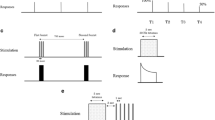Abstract
Purpose of Review
Muscle paralysis is a component of many general anesthetics, and monitoring of neuromuscular function is integral to ensuring complete and safe recovery.
Recent Findings
Recommendations for qualitative neuromuscular blockade have been well-described in the literature for decades; however practitioners frequently do not follow recommendations, resulting in patient harm from inadequate reversal of paralysis.
Summary
This review will focus on evidence-based techniques for patterns of stimulation, sites of monitoring, and accuracy in detecting residual neuromuscular blockade; furthermore, the review will also discuss barriers to implementation of best practices.
Similar content being viewed by others
References
Papers of particular interest have been highlighted as: • Of importance, •• Of outstanding importance
Bevan DR, Donati F, Kopman AF. Reversal of neuromuscular blockade. Anesthesiology. 1992;77:785–805. https://doi.org/10.1097/00000542-199210000-00025.
• Todd MM, Hindman BJ, King BJ. The implementation of quantitative electromyographic neuromuscular monitoring in an academic anesthesia department. Anesth Analg. 2014;119:323–31. Implementation of quantitative neuromuscular blockade monitoring resulted in a significant reduction in the incidence of incompletely reversed patients in the PACU. https://doi.org/10.1213/ANE.0000000000000261.
•• McLean DJ, Diaz-Gil D, Farhan HN, Ladha KS, Kurth T, Eikermann M. Dose-dependent association between intermediate-acting Neuromuscular-blocking agents and postoperative respiratory complications. Anesthesiology. 2015;122(6):1201–13. A study which shows a neuromuscular-blocking agent dose-dependent association with increased risk of respiratory complications in the postoperative period, and also suggesting that the proper use of neostigmine guided by neuromuscular transmission monitoring results can help eliminate postoperative respiratory complications associated with neuromuscular-blocking agents.
Madsen MV, Staehr-Rye AK, Gatke MR, Claudis C. Neuromuscular blockade for optimising surgical conditions during abdominal and gynaecological surgery: a systematic review. Acta Anaesthesiol Scand. 2015;59:1–16. https://doi.org/10.1111/aas.12419.
Fuchs-Buder T, Hofmockel R, Geldner G, Diefenbach C, Ulm K, Blobner M. The use of neuromuscular monitoring in Germany. Anaethesitst. 2003,52–55-6.
Sasaki N1, Meyer MJ, Malviya SA, Stanislaus AB, MacDonald T, Doran ME, et al. Effects of neostigmine reversal of nondepolarizing neuromuscular blocking agents on postoperative respiratory outcomes: a prospective study. Anesthesiology. 2014;121:959–68.
Fuchs-Buder T, Meitelman C, Alla F, Grandjean A, Wuthrich Y, Donati F. Antagonism of low degrees of atracurium-induced neuromuscular blockade. Dose-effect relationships for neostigmine. Anesthesiology. 2010;112:34–40. https://doi.org/10.1097/ALN.0b013e3181c53863.
Fuchs-Buder T, Baumann C, De Guis J, Guerci P, Meistelman C. Low-dose neostigmine to antagonize shallow atracurium neuromuscular block during inhalational anaesthesia. A randomized controlled trial. Eur J Anaesth. 2013;30:594–8. https://doi.org/10.1097/EJA.0b013e3283631652.
Naguib M, Kopman AF, Lien CA, Hunter JM, Lopez A, Brull SJ. A survey of current management of neuromuscular block in the United States and Europe. Anesth Analg. 2010;111:110–9. https://doi.org/10.1213/ANE.0b013e3181c07428.
Grayling M, Sweeney BP. Recovery of neuromuscular blockade: a survey of practice. Anaesthesia. 2007;62:806–9. https://doi.org/10.1111/j.1365-2044.2007.05101.x.
Checketts MR, Alladi R, Ferguson K, et al. Recommendations for standards of monitoring during anaesthesia and recovery 2015: Association of Anaesthestists of Great Britain and Ireland. Anaesthesia. 2015;
Lien CA, Kopman AF. Current recommendations for monitoring depth of neuromuscular blockade. Curr Opin Anesthesiol. 2014;27:616–22.
Brull S, Kopman A. Current status of neuromuscular reversal and monitoring: challenges and opportunities. Anesthesiology. 2017;126:173–90. https://doi.org/10.1097/ALN.0000000000001409.
Ortega R, Brull SJ, Prielipp R, Gutierrez A, De La Cruz R, Conley C. Monitoring neuromuscular function. N Engl J Med. 2018;378:e6. https://doi.org/10.1056/NEJMvcm1603741.
Thilen SR, Hansen BE, Ramaiah R, Kent CD, Treggiari MM, Bhananker SM. Intraoperative neuromuscular monitoring site and residual paralysis. Anesthesiology. 2012;117:964–72. https://doi.org/10.1097/ALN.0b013e31826f8fdd.
Kopman AF, Eikermann M. Antagonism of non-depolarising neuromuscular block: current practice. Anaesthesia. 2009;64(Suppl 1):22–30.
Murphy GS, Szokol JW, Marymont JH, Greenberg SB, Avram MJ, Vender JS, et al. Intraoperative acceleromyographic monitoring reduces the risk of residual neuromuscular blockade and adverse respiratory events in the postanesthesia care unit. Anesthesiology. 2008;109:389–98. https://doi.org/10.1097/ALN.0b013e318182af3b.
Murphy GS, Szokol JW, Marymont JH, Greenberg SB, Avram MJ, Vender JS. Residual neuromuscular blockade and critical respiratory events in the postanesthesia care unit. Anesth Analg. 2008;107:130–7. https://doi.org/10.1213/ane.0b013e31816d1268.
Debaene B, Plaud B, Dilly M-P, Donati F. Residual paralysis in the PACU after a single intubating dose of nondepolorazing muscle relaxant with an intermediate duration of action. Anesthesiology. 2003;98:1042–8. https://doi.org/10.1097/00000542-200305000-00004.
Arbous MS, Meursing AE, van Kleef JW, de Lange JJ, Spoormans HH, Touw P, et al. Impact of anesthesia management characteristics on severe morbidity and mortality. Anesthesiology. 2005;102:257–68. https://doi.org/10.1097/00000542-200502000-00005.
Asbahi M, Soto R. Dosing, monitoring, and reversal of neuromuscular blockade: are anesthesiologists following evidence-based practices? Curr Anesthesiol Rep. 2016;6:160–3. https://doi.org/10.1007/s40140-016-0161-x.
Author information
Authors and Affiliations
Corresponding author
Ethics declarations
Conflict of Interest
Moumen Asbahi and Roy Soto declare they have no conflict of interest.
Human and Animal Rights and Informed Consent
This article does not contain any studies with human or animal subjects performed by any of the authors.
Additional information
This article is part of the Topical Collection on Neuromuscular Blockade
Rights and permissions
About this article
Cite this article
Asbahi, M., Soto, R. Qualitative Neuromuscular Monitoring: Patterns of Stimulation, Site of Monitoring, and Accuracy in Detecting Residual Neuromuscular Blockade. Curr Anesthesiol Rep 8, 130–133 (2018). https://doi.org/10.1007/s40140-018-0268-3
Published:
Issue Date:
DOI: https://doi.org/10.1007/s40140-018-0268-3



